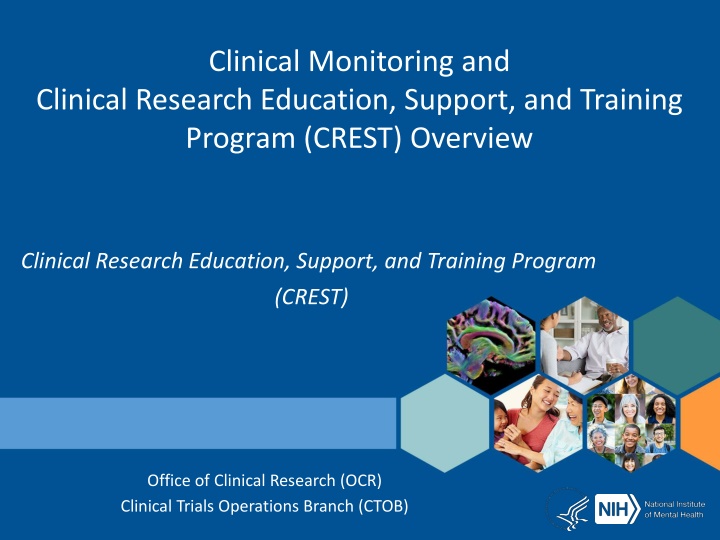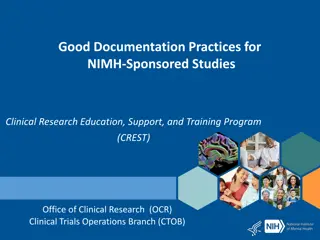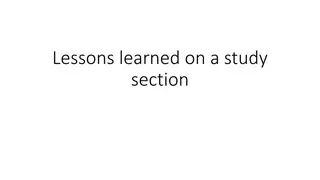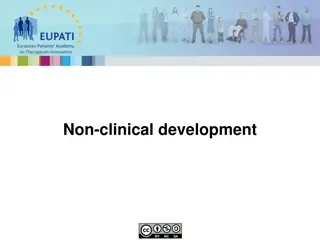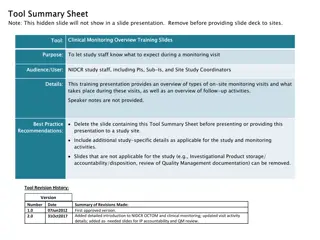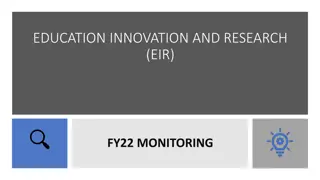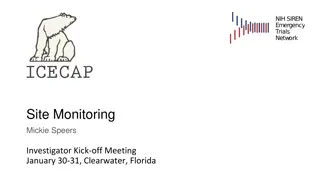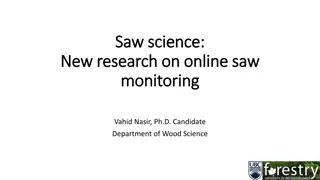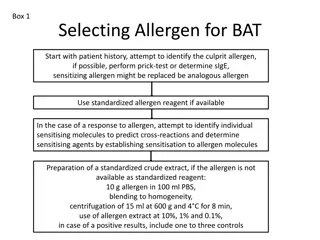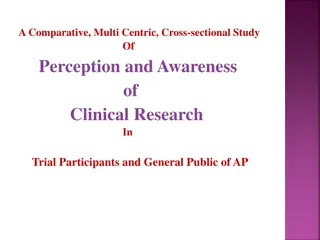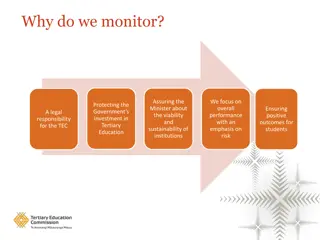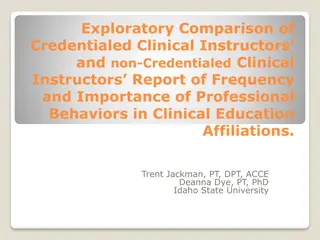NIMH Clinical Research Education and Monitoring Program Overview
NIMH's Clinical Monitoring and Clinical Research Education, Support, and Training Program (CREST) aims to ensure the proper conduct, recording, and reporting of clinical trials. This program includes clinical monitoring plans, guidelines for site monitoring activities, and independent clinical monitoring by contracted associates. Participation in CREST does not exempt study teams from their own monitoring obligations. Adherence to NIMH monitoring expectations is essential for grant recipients.
Download Presentation

Please find below an Image/Link to download the presentation.
The content on the website is provided AS IS for your information and personal use only. It may not be sold, licensed, or shared on other websites without obtaining consent from the author.If you encounter any issues during the download, it is possible that the publisher has removed the file from their server.
You are allowed to download the files provided on this website for personal or commercial use, subject to the condition that they are used lawfully. All files are the property of their respective owners.
The content on the website is provided AS IS for your information and personal use only. It may not be sold, licensed, or shared on other websites without obtaining consent from the author.
E N D
Presentation Transcript
Clinical Monitoring and Clinical Research Education, Support, and Training Program (CREST) Overview Clinical Research Education, Support, and Training Program (CREST) Office of Clinical Research (OCR) Clinical Trials Operations Branch (CTOB)
Objectives and Overview To provide an overview of Clinical Monitoring To describe the NIMH Clinical Research Education Support and Training (CREST) Program Goals Selection process Standard Procedures Site Visits Documents Reviewed Visit Follow- up Communication 3
Clinical Monitoring Clinical monitoring is the act of overseeing the progress of a clinical trial and of ensuring that it is conducted, recorded, and reported in accordance with the protocol, standard operating procedures (SOPs) Good Clinical Practice (GCP) and the applicable regulatory requirement(s). ICH E6 1.38 4
Clinical Monitoring Plan The Clinical Monitoring Plan (CMP) establishes the guidelines for conducting clinical site monitoring activities for NIMH Protocols The CMP details an agreed upon structure to conduct internal or independent review of GCP, human subject safety, and data integrity throughout the lifecycle of a study The CMP includes The group performing monitoring (i.e., site monitor) Timing and frequency of visits Percentage of consent and chart review Remote monitoring capabilities NIMH Clinical Monitoring Plan Template 5
Clinical Research Education, Support and Training (CREST) Program The Clinical Research Education, Support and Training (CREST) Program is part of the NIMH s Office of Clinical Research, Clinical Trials Operations Branch (CTOB) NIMH contracted Clinical Research Associates provide independent clinical monitoring on behalf of NIMH Acceptance of the terms and conditions of grant award includes agreement to be in compliance with NIMH monitoring expectations Inclusion in CREST does not preclude study teams from conducting their own monitoring visits, or from being monitored by other organizations, including institutional QM (quality management) or compliance offices 6
CREST Functions The CREST program assists NIMH-funded studies with: GCP training and NIMH expectations for study conduct Regulatory requirements Site operations Source document and case report form optimization Partial electronic dataset verification Overall study monitoring and quality management questions Provides sites with a comprehensive visit report with recommendations for improving GCP and streamlining study operations Provides ongoing technical support NIMH study teams 7
CREST Selection Process Program Officer (PO) nominated Decisional flow process, may include human subject risk level data safety and monitoring level operational complexity Risk- based considerations, may include significantly greater than minimal risk (see NIMH Risk-Based Monitoring Guidance) study intervention under an FDA IND or IDE other risk or sensitivity (e.g., resource, commitment, political, cultural, etc.,) Other factors (e.g., support education of early stage investigator) Inclusion in CREST occurs at the beginning of the study, but the study may be included in CREST at any time during the study s grant lifecycle 8
CREST Goals Provide educational and technical support to NIMH-funded researchers throughout the lifecycle of the study Help ensure the well-being of study participants is protected and that the study is conducted in compliance with the study protocol, human subject protection requirements, regulations of other applicable agencies, institutional policies, and GCP Maximize study data integrity and validity by confirming that the reported clinical research study data are accurate, complete, and verifiable Enhance the efficiency of clinical research by identifying challenges in study operations or recruitment and assisting study teams to develop mitigation strategies 9
CREST Procedures: Notification Once a study is selected for inclusion in CREST An email is sent from the monitor to the Principal Investigator (PI) to introduce the CREST program and request an initial study call During the initial study call, the monitor provides an introduction and overview of the CREST program as well as procedures, expectations and resources that will be provided 10
CREST Procedures: Visit Scheduling Monitor schedules the visit with the study team Visits are generally scheduled approximately a month ahead of time Intent to Conduct a Site Visit letter goes out to the grantee institution Site visit confirmation letter and tentative agenda is sent to team approximately 2 weeks before visit Request study documents that need to be provided to the monitor for review and read-only access to Electronic Data Capture (EDC) System(s) These include: Protocol, Informed Consent Form (ICF), and Manual of Procedures (MoP), among others These documents should be provided 2 weeks prior to the visit 11
CREST Procedures: Site Visits Site Visits Site Initiation Visit (SIV) Interim Monitoring Visit (IMV) Close Out Visit (COV) Other Remote Monitoring Visit (RMV) Consultation Post- Visit Follow- Up Ongoing communication and support Comprehensive Report Matrix template 12
CREST Site Initiation Visit (SIV) Activities Purpose of the SIV is to assure the team is well positioned for success in conducting the study Ideally, the SIV should occur prior to the enrollment of participants SIVs are typically scheduled for 2 days The monitor will tour the study facilities The monitor reviews Regulatory binder Case Report Form (CRF) templates and Electronic Data Capture (EDC) to ensure they capture the data required by the IRB-approved protocol Study log templates and overall site operations and may make recommendations to optimize these 13
CREST Interim Monitoring Visit (IMV) Activities Purpose of an IMV is to review study procedures, help ensure that the study is conducted according to the protocol, GCP is being followed, data are being accurately entered into the database, fidelity to the intervention is being maintained, that required regulatory approvals are current, and that data quality and integrity meet standards IMVs will occur at regular intervals; typically every 12 months unless the study involves a drug or device, then it may be 6 months. Frequency can be adjusted with PO approval. IMVs are typically scheduled for 3 days. 14
CREST Interim Monitoring Visit (IMV) Activities (continued) The monitor reviews The regulatory binder and up to 100% of signed informed consent forms, AEs, SAEs, protocol deviations/violations Drug/device accountability if applicable A random sample of source documents and CRFs for individual participants The monitor needs access to Consent form review Consent documents Documentation of consent process in chart Chart review/source verification Read-only database access Number of charts, selected data elements and percentage of data in each chart to be reviewed is addressed in the CMP Investigator site file (ISF) review Electronic file Paper file/binder 15
Close-Out Visit (COV) Activities Purpose of the COV is to ensure the quality of the dataset and that no data queries are outstanding COV occurs after the last subject s data is entered and before database lock COVs are typically scheduled for 2-3 days. 16
Close-Out Visit (COV) Activities (continued) The monitor reviews Regulatory binder Completion of data review and source verification up to 100% of study documents since the last IMV (signed informed consent forms, AEs and SAEs, protocol deviations and violations) Drug/device accountability if applicable for subjects dosed since the last IMV Confirmation that Unanticipated Problems (UPs)/Serious Adverse Events (SAEs) have been documented in data collection forms and reported appropriately Confirmation that all laboratory samples have been shipped, as applicable, and appropriately stored Database queries that need resolution prior to database lock Confirmation of change in study status with Institutional Review Board (IRB) Confirmation of study record storage location and that PI is aware of applicable record retention policies and possibility of audits by a regulatory agency or other group in future 17
CREST Procedures: Communication Although the content of these visits is somewhat different, the flow and focus on communication and training is similar During every visit, the monitor communicates with the PI and members of the study team to clarify and resolve issues Each visit begins and ends with a team meeting The type of visit dictates the content of those meetings, for example, in a SIV the initial meeting will include a GCP presentation whereas for an IMV, the initial meeting will include an update on study progress and recruitment Likewise at the conclusion of the visit, the monitor will meet with the PI and study team to review any finding or recommendations from the visit and answer questions Ongoing communication and support: PIs and study teams are encouraged to reach out to monitor staff for ongoing concerns or questions 18
CREST Procedures: Site Visit Report After the visit, written feedback is provided in the form of a Site Visit Report Typically the report is sent via email to the site within 4 weeks of the visit Internally, the report is reviewed by CTOB leadership and the PO The report will include any Action Items that require clarification within 30 calendar days Action items are to be submitted via email to the PO with a CC to the monitor 19
CREST Visit Requirements During site visits, the monitor will need access to the following: Workspace Regulatory/ Investigator site file (including access to ISF documents maintained electronically, if applicable) Research records (paper and electronic) All signed consent forms 20
CREST Clinical Monitoring The monitor will review study documents and may observe study processes to confirm adherence to: Good Clinical Practice (GCP) Data integrity Informed consent process and documentation Study protocol All other applicable regulations 21
Investigator Site/ Regulatory File Review The monitor will review and verify: All required essential documents Regulatory Document Checklists All documents are current and expired documents are replaced, with maintenance of previous versions Delegation of Authority/ Responsibilities Log to ensure it is current and includes all site staff with signatures and appropriate study responsibilities Study Training Logs Sign Monitoring Visit Log for each day of the visit 22
Consent Form(s) Review Obtained prior to initiation of study procedures Process documented in source Date and time Version reviewed Study personnel conducting the discussion(s) Topics discussed with participant Adequate time for review of consent and questions Participant received copy of consent document Documentation of Informed Consent Valid signatures and dates Correct version signed, including updates 23
Source Documentation and Data Collection Form to Database Review The monitor will review and verify: Accurate, complete, and current source documentation is being maintained Participant eligibility Participant Pre-Screening Log Participant Enrollment Log Inclusion/ Exclusion Checklist Completion of protocol-specified procedures Proper documentation and reporting of UPs/SAEs in the source and data collection forms/database Accuracy of data recorded on data collection forms Items entered directly in the database 24
Unanticipated Problem(s)/Serious Adverse Event(s) Review The monitor will: Follow-up on previously reported UPs/SAEs Verify all newly reported events against source documentation Identify unreported events recorded in source documentation Confirm events reported to IRB and as outlined in the protocol Study-Wide AE Log Template Subject-Specific AE Log Template 25
Protocol Deviation(s) Review The monitor will: Identify potential deviations for discussion with study team Verify that deviations are documented in source Verify deviations were reported to the IRB per their guidelines Address deviations with site personnel and establish plans to prevent future occurrence Study-Wide Protocol Deviation Log Subject-Specific Protocol Deviation Log 26
Investigational Product (IP) Accountability Review The monitor will: Confirm shipping, storage, dispensing, and return of IP are occurring according to the protocol and MOP/SOPs IP Management SOP Perform IP counts for stock and returned supply against dispensing logs Master IP Dispensing and Accountability Log Subject IP Dispensation and Accountability Log Confirm proper disposition of used/unused IP 27
Quality Management (QM) Review The monitor will: Review site-level QM reports against the QM Plan, for studies with on-site clinical monitoring where QM reports are not sent to NIMH Note resolution of items noted in QM reports Note any suggested items for follow-up or action based on QM findings 28
Summary Our monitoring is focused on Clinical Research Education Support and Training of NIMH-funded Investigators and their teams We strive for the monitoring process to be collaborative and helpful CREST and CTOB staff are available for consultation and ongoing collaboration Feedback is encouraged Sites are able to apply lessons learned and improve their research practices across their portfolios 29
Contact NIMH Office of Clinical Research (OCR) Clinical Research Education, Support, and Training (CREST) Program Email: nimhctob_crest@mail.nih.gov 30
